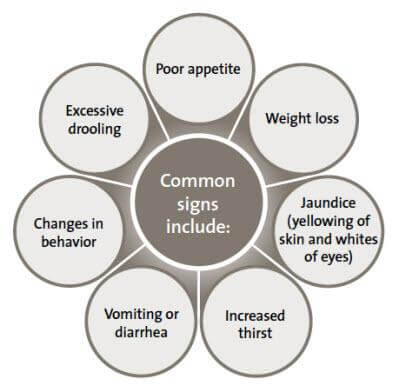
If you’re a dog lover then you already know how important dogs are in our life. They are part of the family. You and your dog may even communicate with each other on a level that is unseen but felt. That is why it can be so very difficult when you sense that something is not quite right with your furry friend. While you share a special communication with your pooch, you may still not fully understand what they may be feeling when something is wrong. When it comes to liver disease in dogs, it is important to know exactly what it is, what to look for, and how to prevent it before it begins or gets worse.
Unfortunately, dogs cannot simply come right out and tell us that something is wrong. Illness and disease in a dog can be quite difficult since dogs have a tendency to mask their discomfort in ways that we do not.

The Liver is a multi-purpose organ that works behind the scenes in both humans and dogs. It is vital in detoxifying the blood, eliminating harmful toxins, producing bile acids for digestion, storing vitamins and glycogen, and metabolizing sources of energy. The liver plays an important role in making sure that the body runs smoothly.
If the liver isn’t functioning properly in your dog, they can suffer from a wide array of health issues and conditions. A diseased liver can have a negative domino effect on the health and well being of a dog. It can start off slowly and then quickly escalate to something more severe. While it is most commonly diagnosed in older dogs, some puppies are born with a condition that is called liver shunt. There are also certain breeds of dog that are more prone to developing liver disease.

Liver disease is actually quite common in dogs. It has been found that three percent of the diseases veterinarians come across are related to the liver. Liver disease is also the fifth leading cause of death among dogs.
There are two types of liver diseases that can affect dogs. These include acute liver disease and chronic liver disease. Acute liver disease develops suddenly and the primary cause is due to poisoning. This can be common in dogs since they have a habit of getting into things they are better off leaving alone. To explore more about it at Petcaveco
Chronic liver disease is a gradual process that develops over time. This type is most commonly caused by other diseases and conditions such as diabetes or cancer, and is difficult to detect early on. Certain breeds of dogs can be more prone to developing conditions that may lead to liver disease as they age.

There are several things that can cause liver disease in dogs. While liver disease can be the result of aging or genetics, there are other factors that may play a role in the development of liver conditions. Certain medications can result in damage to the liver. Liver problems can also develop when there are issues with the pancreas, untreated heartworms, or if your dog suffers from diabetes.
An unforeseen problem that can be detrimental to your dog and their liver health are environmental factors. These can include mold that grows on corn, blue-green algae, certain mushrooms, and various plants and herbs around the yard such as Feeding your dog fatty foods can also lead to liver disease.
There are many important signs to look for when trying to determine if your dog may be suffering from liver disease. Unfortunately, many of the signs can be quite unspecific. If you suspect that your dog may have any of these symptoms it is important to have them checked by a veterinarian.

The most common sign of the early-onset liver disease is jaundice. This is when the skin gets a yellowish appearance and can be most easily recognized in dogs by checking their gums, eyes, and ears.
Gastrointestinal issues are another common symptom of early-stage liver damage. These can include weight loss, decreased appetite, vomiting, and diarrhea. Changes in stool color, and an increase in drinking and urination.
While the first two mentioned are the most common. It is important to be aware of some of the other symptoms that can occur with your dog. These can include blood in the urine and feces, lack of coordination, lethargy, excessive drooling, behavior changes, confusion, and even blindness, and seizures.
Knowing which dog breeds are most susceptible to liver disease is an important first step. Labrador retrievers, Doberman pinschers, and cocker spaniels are some of the breeds that are more commonly affected by liver conditions. Knowing this ahead of time can help you to be aware of the potential. Catch the early onset of symptoms for treatment.
Another important step to prevention is making sure that your dog’s environment is safe. If you have a fenced-in yard and your dog leisurely roams the property then you’ll want to make sure that there aren’t any harmful plants, herbs, or molds. It is also important to make sure that they do not get into anything harmful while taking them for their daily walks.

Knowing how to prevent liver disease in your dog is an important first step. To make sure that they live a long and healthy life. Spotting the signs and symptoms can help you to stop the spread of the disease. Begin treatment before it gets any worse.
While finding out that your fur-faced friend is suffering from an unforeseen illness can be devastating. It does not mean that the situation is helpless. There are many different treatments that can help slow or eliminate the process of liver disease. Your veterinarian can help you determine which steps to take.
Your dog may need to go on a special diet to ensure. That they are getting the proper nutrition to aid in liver improvement. Certain supplements such as milk thistle and SAM-E can help with their liver recovery. Your vet may prescribe medications to help control liver problems as well as removing other medications that could be detrimental. Finally, surgery may be in order if your dog is suffering from tumors or cysts.
To get more information :











